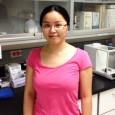
Engineering students help advance diabetes research

Biomedical engineering grad student Teagan Adamson is the lead author for a paper on diabetes research based on work she did as an undergraduate.
Arizona State University engineering students are contributing to research to aid people with diabetes. Two reports published recently in major medical research journals detail advances in which students have been involved.
Teagan Adamson, a biomedical engineering graduate student, is the lead author of an article in the journal Analyst about improvements in technology for diabetes monitoring. It’s based on research she performed as an undergraduate as the basis for her honors thesis in ASU’s Barrett, The Honors College.
Biomedical engineering undergraduate Francis Eusebio is a co-author. Corresponding authors are Jeffrey La Belle, an assistant research professor in the School of Biological and Health Systems Engineering, and physician Curtiss Cook, a professor of medicine and an endocrinologist at Mayo Clinic in Arizona.
The research was carried out in La Belle’s lab under his direction.
The article describes work on a multiplexable diabetes electrochemical impedance-based sensor. The project’s goal is to enable people with diabetes to monitor their conditions using multiple bio-indicators in the blood such as insulin and hemoglobin in addition to traditional blood glucose measurement.
Read the report at http://pubs.rsc.org/en/

Chemical engineering doctoral student Mingzhi Dai helped author a paper on development of new diabetes-monitoring technology.
Another research report, published in the journal Analytica Chimica Acta, is authored by chemical engineering doctoral student Mingzhi Dai and biomedical engineering undergraduate Stephanie Maxwell, along with La Belle and Bryan Vogt, an associate professor in the Department of Polymer Engineering at the University of Akron.
The project was also conducted under La Belle’s direction.
The article describes work on a new amplified and interferent-blocking mesoporous carbon ink-electrochemical for diabetes monitoring. Read the report at http://dx.doi.org/10.1016/j.aca.2012.05.038
La Belle says the technologies have the potential to improve not only diabetes diagnosis and monitoring but also diagnoses of cancer, cardiovascular disease, and ailments and diseases related to physical stress, as well as provide another form of pregnancy testing.



































